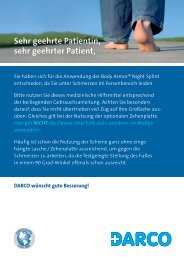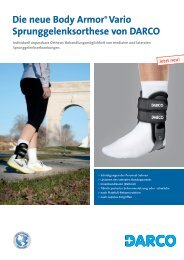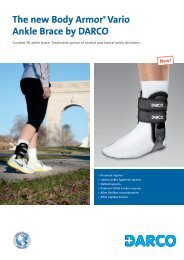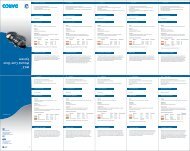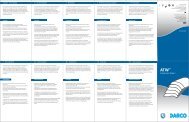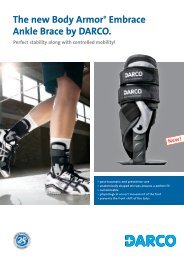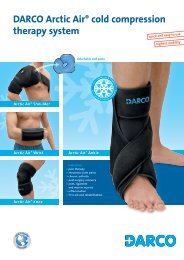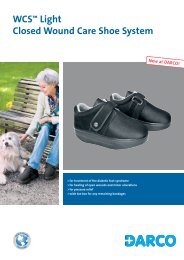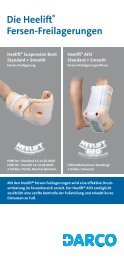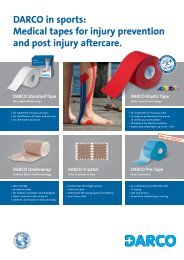Gebrauchsanweisung OPTIMA Insole 3x3 - Darco
Gebrauchsanweisung OPTIMA Insole 3x3 - Darco
Gebrauchsanweisung OPTIMA Insole 3x3 - Darco
Erfolgreiche ePaper selbst erstellen
Machen Sie aus Ihren PDF Publikationen ein blätterbares Flipbook mit unserer einzigartigen Google optimierten e-Paper Software.
<strong>OPTIMA</strong> <strong>Insole</strong> 3 × 3 Heel<br />
<strong>OPTIMA</strong> <strong>Insole</strong> 3 × 3<br />
<strong>OPTIMA</strong><br />
<strong>Insole</strong> 3 × 3 (Heel)<br />
Distributor<br />
DARCO (Europe) GmbH<br />
Gewerbegebiet 18<br />
82399 Raisting, Germany<br />
Telefon +49 (0) 88 07. 92 28-0 | Fax -22<br />
info@darco.de, www.darco.de<br />
Salvatelli S.r.l.<br />
Via Breda 19/21<br />
I-62012 Civitanova Marche (MC)<br />
Telefon +39 07 33. 80 10-60 | Fax -48<br />
info@molliter.com, www.molliter.com<br />
130325<br />
D Indikationen<br />
> zur gezielten Druckumverteilung bei akuten Versorgungen<br />
Vorsicht<br />
> Das Tragen von Verbandstoffen oder Socken wird empfohlen.<br />
> Die Sohle muss immer komplett ausgefüllt sein (9 Teile), um eine gezielte Druckumverteilung<br />
zu erreichen. Verwenden Sie die Sohle nicht, wenn ein Modul fehlt.<br />
> Bei unsachgemäßer Handhabung des Produkts ist die Funktion und ein optimaler<br />
Schutz nicht mehr gewährleistet.<br />
Technische Daten<br />
5 Größen:<br />
S (34 – 36), M (37 – 39), L (40 –42), XL (43 – 45), XXL (46 – 48)<br />
Rechts und links tragbar.<br />
Wartung:<br />
Das Produkt ist wartungsfrei.<br />
Für folgende Hilfsmittel in den entsprechenden Größen erhältlich:<br />
> <strong>OPTIMA</strong> Diab – Unterschenkelfußorthese<br />
> <strong>OPTIMA</strong> Heel – Unterschenkelfußorthese<br />
> <strong>OPTIMA</strong> PostOP – Hoher Langzeitverbandschuh<br />
> <strong>OPTIMA</strong> Europa – Langzeitverbandschuh<br />
> <strong>OPTIMA</strong> Free – Offener Langzeitverbandschuh<br />
Im Lieferumfang enthalten:<br />
Bearbeitungs-Set für den Techniker<br />
1 Markierstift, Skalpell und Mess-Schablone<br />
Reinigungshinweise<br />
Die Sohlen können mit lauwarmem Wasser und Seife oder mit handelsüblichen<br />
Desinfektionsmitteln gereinigt werden.<br />
USA / GB Indications<br />
> for selective off-loading and acute treatments<br />
Caution<br />
> It is recommended to wear bandages or socks.<br />
> The sole has to always include all parts (9 parts) for achieving selective off-loading.<br />
Do not use if one module is missing.<br />
> If the product is improperly handled its function and optimal safety can no longer<br />
be guaranteed.<br />
Technical data<br />
5 Sizes:<br />
S (34 – 36), M (37 – 39), L (40 –42), XL (43 – 45), XXL (46 – 48)<br />
Right and left fit.<br />
Maintenance:<br />
The product does not require maintenance.<br />
All required sizes available for the following foot and ankle products:<br />
> <strong>OPTIMA</strong> Diab – Lower leg foot orthosis<br />
> <strong>OPTIMA</strong> Heel – Lower leg foot orthosis<br />
> <strong>OPTIMA</strong> PostOP – High Wound Care Shoe<br />
> <strong>OPTIMA</strong> Europa – Wound Care Shoe<br />
> <strong>OPTIMA</strong> Free – Open Wound Care Shoe<br />
Included with delivery:<br />
Work set for technicians<br />
1 marker pen, scalpel and measuring template<br />
Cleaning instructions<br />
The soles can be cleaned with warm water and soap or regular disinfectants.<br />
Notizen:<br />
Notes:
1.<br />
3.<br />
5.<br />
7.<br />
<strong>OPTIMA</strong> <strong>Insole</strong> 3 × 3<br />
<strong>OPTIMA</strong> <strong>Insole</strong> 3 × 3 Heel<br />
2.<br />
4.<br />
6.<br />
D Gebrauchshinweis<br />
<strong>OPTIMA</strong> <strong>Insole</strong> 3 × 3 (Heel)<br />
Modulare Innensohle<br />
Die modulare Innensohle wurde zur plantaren Druckumverteilung entwickelt<br />
und kommt speziell bei Druck-Ulcera am Vor- und Mittelfuß oder an der Ferse zum<br />
Einsatz.<br />
1. Das <strong>OPTIMA</strong> <strong>Insole</strong> 3 × 3 Sohlensystem besteht aus neun verschiedenen Einzelteilen,<br />
die ähnlich einem Puzzle zu einer dreilagigen Einlage zusammengesetzt werden.<br />
2. Die Sohlen bestehen aus drei unterschiedlichen Shore-Härten (weich = rot,<br />
mittel = beige und hoch = blau) und sind senkrecht und waagerecht kombinierbar.<br />
Das einfache Austau schen der Module erlaubt eine optimale, indikationsabhängige<br />
Druckverteilung für den Patienten, die in dringenden Fällen auch ambulant mit<br />
wenigen, einfachen Handgriffen durchzuführen ist.<br />
3. Um eine Entlastung an einer ulzerierten Stelle an der Fußsohle zu erreichen kann<br />
man die Sohlenelemente individuell bearbeiten.<br />
Ulcus-Markierung und Zuschnitt der Sohlen:<br />
Patient unter 90 kg (Markierung der Druckulcera auf der beigen Sohle!)<br />
1. Decken Sie das Druckulcus mit einem transparenten Pflaster ab und markieren Sie<br />
das Druckulcus mit dem mitgelieferten Markierstift auf dem transparenten Pflaster<br />
am Fuß des Patienten (Bild 1).<br />
2. Legen Sie das komplette <strong>OPTIMA</strong> <strong>Insole</strong> 3 × 3 Sohlensystem in den Schuh ein und<br />
achten Sie darauf, dass die beige Sohle oben liegt. (beige – rot – blau)<br />
3. Der Patient sollte sich nun in den Schuh auf die Innensohle stellen und einige Schritte<br />
mit dem geschlossenen Schuh gehen und so das Ulcus auf der obersten (beigen)<br />
Schicht der Innensohle markieren (Bild 2). Hinweis: Den Patient gegebenenfalls<br />
stützen.<br />
4. Öffnen Sie nun den Schuh und entnehmen Sie das komplette Sohlensystem.<br />
5. Zeichnen Sie nun auf der Oberseite der beigen Sohle in circa 1,5 cm Abstand zur<br />
Farb markierung den zu entfernenden Ausschnitt ein (Bild 3).<br />
6. Perforieren Sie die beige Sohle mit einer Stechahle entlang der markierten Stelle<br />
(Bild 4).<br />
7. Drehen Sie die beige Sohle um und scheiden Sie auf der nichtmarkierten Seite mit<br />
einem scharfen Messer oder dem mitgelieferten Skalpell in 45° Neigung entlang der<br />
Perforations linie die Entlastungszone aus (Bild 5 und 6).<br />
8. Setzen Sie nun je nach Druckumverteilung die einzelnen Sohlenteile wieder zusammen<br />
(siehe Graphik) und legen sie das individuell angepasste Sohlensystem in<br />
den Schuh ein.<br />
9. Achten Sie darauf, dass die zugeschnittene Sohle die mittlere Sohlenlage bildet!<br />
10. Nach Anlegen eines Verbandes oder einer Socke kann dem Patienten nun der Schuh<br />
angelegt werden (Bild 7).<br />
11. Die Klettverschlüsse können je nach Bedarf gekürzt werden.<br />
Anwendungsbeispiel: Patient unter 90 kg<br />
Druckaufnahme<br />
(hohe Shore-Härte)<br />
USA/GB Instructions for use<br />
<strong>OPTIMA</strong> <strong>Insole</strong> 3 × 3 (Heel)<br />
Modular <strong>Insole</strong><br />
Pressure absorption<br />
(high shore hardness)<br />
Entlastung<br />
(weiche Shore-Härte)<br />
Entlastungszone<br />
The modular inner sole was developed to redistribute plantar pressure and is used<br />
specifically with pressure ulcers on the fore-, midfoot or heel.<br />
1. The <strong>OPTIMA</strong> <strong>Insole</strong> 3 × 3 sole system comprises nine different parts, which are<br />
arranged like a puzzle to form a three-layer inlay.<br />
2. The soles consist of three different shore hardnesses (soft = red, medium = beige<br />
and high = blue) and can be combined vertically and horizontally. Simply exchanging<br />
the modules enables patients to distribute pressure optimally subject to indication.<br />
In urgent cases this can be done on an outpatient basis in a few simple steps.<br />
3. To achieve relief in an ulcerated area of the sole, you can adapt the sole elements<br />
individually.<br />
Ulcer marking and cutting the soles:<br />
Patient lighter than 90 kg (Mark the pressure ulcers on the beige sole!)<br />
1. Cover the pressure ulcer with a transparent plaster and use the supplied marker pen<br />
to mark the pressure ulcer on the transparent plaster on the patient’s foot (Fig. 1).<br />
2. Insert the whole <strong>OPTIMA</strong> <strong>Insole</strong> 3 × 3 sole system into the shoe and ensure that the<br />
beige sole lies on top. (beige – red – blue)<br />
3. The patient should now stand on the inner sole in the shoe and walk a few paces<br />
with the shoe closed to mark the ulcer on the uppermost (beige) layer of the inner<br />
sole (Fig. 2). Note: Assist the patient if required.<br />
4. Now unfasten the shoe and remove the entire sole system.<br />
5. Proceed to mark the cut-out to be removed on the top side of the beige sole and<br />
allow about 1.5 cm of clearance to the colour marking (Fig. 3).<br />
6. Perforate the beige sole along the marked area with a punch tool (Fig. 4).<br />
7. Turn the beige sole over and use a sharp knife or the supplied scalpel to cut out the<br />
relief zone at a 45° slant along the perforation line on the unmarked side (Figs. 5<br />
and 6).<br />
8. Now reassemble the individual sole parts according to the pressure redistribution<br />
(see diagram) and insert the individually adapted sole system into the shoe.<br />
9. Ensure that the sole you have cut forms the middle layer of the sole!<br />
10. After putting on a bandage or a sock, the shoe can now be fitted to the patient<br />
(Fig. 7).<br />
11. The velcro® fasteners can be shortened as required.<br />
Typical application: patient lighter than 90 kg<br />
Relief<br />
(soft shore hardness)<br />
Relief Zone<br />
45°<br />
45°<br />
Patient über 90 kg (Markierung der Druckulcera auf der blauen Sohle!)<br />
1. Decken Sie das Druckulcus mit einem transparenten Pflaster ab und markieren Sie<br />
das Druckulcus mit dem mitgelieferten Markierstift auf dem transparenten Pflaster<br />
am Fuß des Patienten (Bild 1).<br />
2. Legen Sie das komplette <strong>OPTIMA</strong> <strong>Insole</strong> 3 × 3 Sohlensystem in den Schuh ein und<br />
achten Sie darauf, dass die blaue Sohle oben liegt. (blau – beige – rot)<br />
3. Der Patient sollte sich nun in den Schuh auf die blaue Innensohle stellen und einige<br />
Schritte mit dem geschlossenen Schuh gehen und so das Ulcus auf der obersten<br />
(blauen) Schicht der Innensohle markieren (analog Bild 2, aber mit blauer Sohle).<br />
Hinweis: Den Patient gegebenenfalls stützen.<br />
4. Öffnen Sie nun den Schuh und entnehmen Sie das komplette Sohlensystem.<br />
5. Zeichnen Sie nun auf der Oberseite der blauen Sohle in circa 1,5 cm Abstand zur Farbmarkierung<br />
den zu entfernenden Ausschnitt ein (analog Bild 3, aber mit blauer Sohle).<br />
6. Legen Sie die beige Sohle unter die blaue Sohle und perforieren Sie beide Sohlen mit<br />
einer Stechahle entlang der markierten Stelle (analog Bild 4).<br />
7. Drehen Sie die blaue Sohle um und scheiden Sie auf der nichtmarkierten Seite mit<br />
einem scharfen Messer oder dem mitgelieferten Skalpell in 45° Neigung entlang der<br />
Perforations linie die Entlastungszone 1 aus (analog Bild 5 und 6).<br />
8. Schneiden Sie auf der beigen Sohle die Entlastungszone 2 in gleicher Weise aus.<br />
9. Setzen Sie nun je nach Druckumverteilung die einzelnen Sohlenteile wieder zusammen<br />
(siehe Graphik) und legen sie das individuell angepasste Sohlensystem in<br />
den Schuh ein.<br />
10. Achten Sie darauf, dass die Entlastungszone 1 die mittlere Sohlenlage bildet!<br />
11. Legen Sie das individuell angepasste Sohlensystem in den Schuh ein.<br />
12. Nach Anlegen eines Verbandes oder einer Socke kann dem Patienten nun der Schuh<br />
angelegt werden (Bild 7).<br />
13. Die Klettverschlüsse können je nach Bedarf gekürzt werden.<br />
Anwendungsbeispiel: Patient über 90 kg<br />
Druckaufnahme<br />
(hohe Shore-Härte)<br />
Zuschnitt bei Druckumverteilungszonen im Bereich über zwei Puzzleteilen:<br />
Sollte der Zuschnitt der Entlastungszonen über zwei Puzzleteile gehen, empfiehlt es<br />
sich die beiden Teile vor Zuschnitt an der Verbindungsstelle mit einem Klebeband zu<br />
fixieren.<br />
Patient lighter than 90 kg (Mark the pressure ulcers on the blue sole!)<br />
1. Cover the pressure ulcer with a transparent plaster and use the supplied marker pen<br />
to mark the pressure ulcer on the transparent plaster on the patient’s foot (Fig. 1).<br />
2. Insert the whole <strong>OPTIMA</strong> <strong>Insole</strong> 3 × 3 sole system into the shoe and ensure that<br />
the blue sole lies on top. (blue – beige – red)<br />
3. The patient should now stand in the shoe on the blue inner sole and walk a few<br />
paces with the shoe closed to mark the ulcer on the uppermost (blue) layer of the<br />
inner sole (like in Fig. 2, but with blue sole). Note: Assist the patient if required.<br />
4. Now unfasten the shoe and remove the entire sole system.<br />
5. Proceed to mark the cut-out to be removed on the top side of the blue sole and allow<br />
about 1.5 cm of clearance to the colour marking (like in Fig. 3, but with blue sole).<br />
6. Place the beige sole beneath the blue sole and perforate both soles along the marked<br />
area with a punch tool (like in Fig. 4).<br />
7. Turn the blue sole over and use a sharp knife or the supplied scalpel to cut out<br />
Relief Zone 1 at a 45° slant along the perforation line on the unmarked side<br />
(like in Figs. 5 and 6).<br />
8. Cut out Relief Zone 2 on the beige sole in the same way.<br />
9. Now reassemble the individual sole parts according to the pressure redistribution<br />
(see diagram) and insert the individually adapted sole system into the shoe.<br />
10. Ensure that Relief Zone 1 forms the middle layer of the sole!<br />
11. Insert the individually adapted sole system into the shoe.<br />
12. After putting on a bandage or a sock, the shoe can now be fitted to the patient<br />
(Fig. 7).<br />
13. The velcro® fasteners can be shortened as required.<br />
Typical application: patient heavier than 90 kg<br />
Pressure absorption<br />
(high shore hardness)<br />
Entlastung<br />
(weiche Shore-Härte)<br />
Entlastungszone 1<br />
Entlastungszone 2<br />
45°<br />
Relief<br />
(soft shore hardness)<br />
Relief Zone 1<br />
Relief Zone 2<br />
45°<br />
Cutting with pressure redistribution zones covering two puzzle parts:<br />
If cutting the relief zones should cover two puzzle parts, it is advisable to anchor<br />
the two parts with adhesive tape before cutting at the join.



